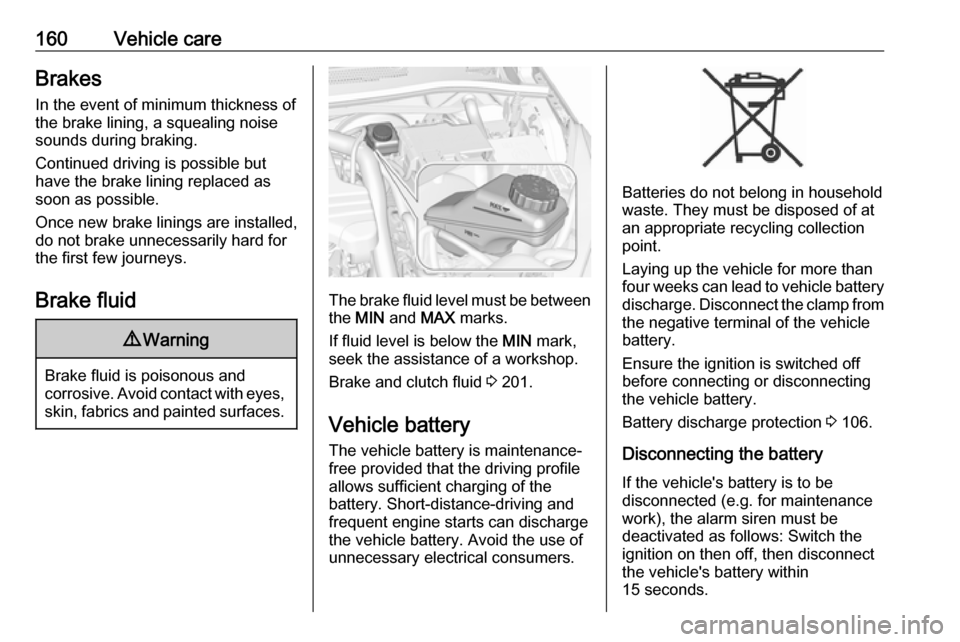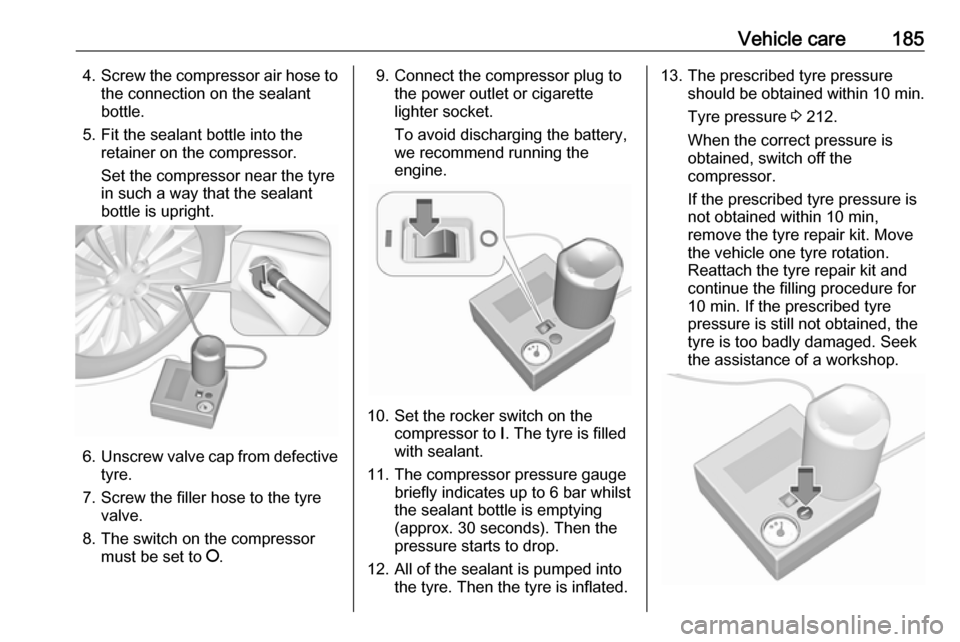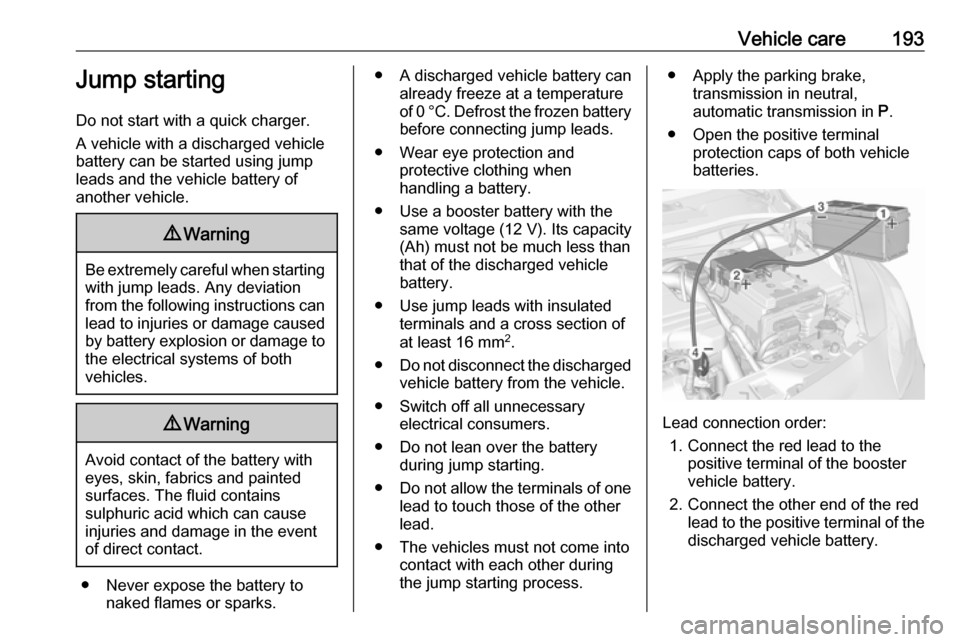battery VAUXHALL CORSA F 2019 Owner's Guide
[x] Cancel search | Manufacturer: VAUXHALL, Model Year: 2019, Model line: CORSA F, Model: VAUXHALL CORSA F 2019Pages: 229, PDF Size: 6.72 MB
Page 162 of 229

160Vehicle careBrakesIn the event of minimum thickness of
the brake lining, a squealing noise
sounds during braking.
Continued driving is possible but
have the brake lining replaced as
soon as possible.
Once new brake linings are installed,
do not brake unnecessarily hard for
the first few journeys.
Brake fluid9 Warning
Brake fluid is poisonous and
corrosive. Avoid contact with eyes, skin, fabrics and painted surfaces.
The brake fluid level must be betweenthe MIN and MAX marks.
If fluid level is below the MIN mark,
seek the assistance of a workshop.
Brake and clutch fluid 3 201.
Vehicle battery
The vehicle battery is maintenance-
free provided that the driving profile
allows sufficient charging of the
battery. Short-distance-driving and
frequent engine starts can discharge
the vehicle battery. Avoid the use of
unnecessary electrical consumers.
Batteries do not belong in household
waste. They must be disposed of at
an appropriate recycling collection
point.
Laying up the vehicle for more than
four weeks can lead to vehicle battery
discharge. Disconnect the clamp from
the negative terminal of the vehicle
battery.
Ensure the ignition is switched off
before connecting or disconnecting
the vehicle battery.
Battery discharge protection 3 106.
Disconnecting the battery If the vehicle's battery is to be
disconnected (e.g. for maintenance
work), the alarm siren must be
deactivated as follows: Switch the
ignition on then off, then disconnect
the vehicle's battery within
15 seconds.
Page 163 of 229

Vehicle care161Replacing the vehicle batteryNotice
Any deviation from the instructions
given in this section may lead to
temporary deactivation or
disturbance of the stop-start system.
When the vehicle battery is being
replaced, please ensure that there
are no open ventilation holes in the
vicinity of the positive terminal. If a
ventilation hole is open in this area, it
must be closed off with a dummy cap, and the ventilation in the vicinity of the
negative terminal must be opened.
Ensure that the battery is always replaced by the same type of battery.
We recommend the use of an originalVauxhall battery.
Notice
Using an AGM vehicle battery
different from the original Vauxhall vehicle battery may result in a lower
performance.
We recommend that you have the
vehicle battery replaced by a
workshop.Charging the vehicle battery9 Warning
On vehicles with stop-start
system, ensure that the charging potential does not exceed 14.6 V
when using a battery charger.
Otherwise the vehicle battery may be damaged.
Jump starting 3 193.
Stop-start system 3 120.
Warning label
Meaning of symbols: ● No sparks, naked flames or smoking.
● Always shield eyes. Explosive gases can cause blindness or
injury.
● Keep the vehicle battery out of the reach of children.
● The vehicle battery contains sulfuric acid which could cause
blindness or serious burn
injuries.
● See the Owner's manual for further information.
● Explosive gas may be present in the vicinity of the battery.
Page 174 of 229

172Vehicle careNo.Circuit1-2-3Battery sensor4Chassis control module, fuel
pump5ABS6Low beam and daytime running
light left, Xenon high beam7–8LPG control module9Body control module10Headlamp levelling11Rear wiper12Heated rear window13Low beam and daytime running
light right14Heated exterior mirror15–No.Circuit16Brake booster kit17Ignition signal, waterpump18Engine control module19Fuel pump20–21Engine solenoids, engine
sensors22–23Ignition coils, injectors24Washer system25–26Engine sensors27Engine management28Engine control module29Engine control module30Engine control module31High beam left, Xenon low
beam left
Page 187 of 229

Vehicle care1854.Screw the compressor air hose to
the connection on the sealant
bottle.
5. Fit the sealant bottle into the retainer on the compressor.
Set the compressor near the tyre
in such a way that the sealant
bottle is upright.
6. Unscrew valve cap from defective
tyre.
7. Screw the filler hose to the tyre valve.
8. The switch on the compressor must be set to J.
9. Connect the compressor plug to
the power outlet or cigarette
lighter socket.
To avoid discharging the battery,
we recommend running the
engine.
10. Set the rocker switch on the compressor to I. The tyre is filled
with sealant.
11. The compressor pressure gauge briefly indicates up to 6 bar whilstthe sealant bottle is emptying
(approx. 30 seconds). Then the
pressure starts to drop.
12. All of the sealant is pumped into the tyre. Then the tyre is inflated.
13. The prescribed tyre pressure should be obtained within 10 min.
Tyre pressure 3 212.
When the correct pressure is
obtained, switch off the
compressor.
If the prescribed tyre pressure is
not obtained within 10 min,
remove the tyre repair kit. Move
the vehicle one tyre rotation.
Reattach the tyre repair kit and
continue the filling procedure for
10 min. If the prescribed tyre
pressure is still not obtained, the
tyre is too badly damaged. Seek
the assistance of a workshop.
Page 189 of 229

Vehicle care187
1. Take the sealant bottle andbracket with air hose from the
insert.
2. Detach air hose from bracket and screw onto sealant bottle
connection.
3. Position the sealant bottle on the bracket. Make sure that the bottle
does not fall.
4. Unscrew valve cap from defective
tyre.
5. Screw tyre inflation hose to valve.
6. Screw air hose onto compressor connection.
7. Switch on ignition. To avoid discharging the battery,
we recommend running the
engine.
Page 195 of 229

Vehicle care193Jump starting
Do not start with a quick charger.
A vehicle with a discharged vehicle
battery can be started using jump
leads and the vehicle battery of
another vehicle.9 Warning
Be extremely careful when starting
with jump leads. Any deviation
from the following instructions can
lead to injuries or damage caused
by battery explosion or damage to the electrical systems of both
vehicles.
9 Warning
Avoid contact of the battery with
eyes, skin, fabrics and painted
surfaces. The fluid contains
sulphuric acid which can cause
injuries and damage in the event
of direct contact.
● Never expose the battery to naked flames or sparks.
● A discharged vehicle battery canalready freeze at a temperature
of 0 °C. Defrost the frozen battery
before connecting jump leads.
● Wear eye protection and protective clothing when
handling a battery.
● Use a booster battery with the same voltage (12 V). Its capacity
(Ah) must not be much less than
that of the discharged vehicle battery.
● Use jump leads with insulated terminals and a cross section of
at least 16 mm 2
.
● Do not disconnect the discharged
vehicle battery from the vehicle.
● Switch off all unnecessary electrical consumers.
● Do not lean over the battery during jump starting.
● Do not allow the terminals of one
lead to touch those of the other
lead.
● The vehicles must not come into contact with each other during
the jump starting process.● Apply the parking brake, transmission in neutral,
automatic transmission in P.
● Open the positive terminal protection caps of both vehicle
batteries.
Lead connection order:
1. Connect the red lead to the positive terminal of the booster
vehicle battery.
2. Connect the other end of the red lead to the positive terminal of the
discharged vehicle battery.
Page 196 of 229

194Vehicle care3. Connect the black lead to thenegative terminal of the booster
vehicle battery.
4. Connect the other end of the black
lead to a vehicle grounding point,
such as the engine block or an
engine mounting bolt. Connect as far away from the discharged
vehicle battery as possible,
however at least 60 cm.
Route the leads so that they cannot
catch on rotating parts in the engine
compartment.
To start the engine: 1. Start the engine of the vehicle providing the jump.
2. After 5 minutes, start the other engine. Start attempts should be
made for no longer than
15 seconds at an interval of 1 minute.
3. Allow both engines to idle for approx. 3 minutes with the leads
connected.4. Switch on electrical consumers (e.g. headlights, heated rear
window) of the vehicle receiving
the jump start.
5. Reverse above sequence exactly when removing leads.Towing
Towing the vehicle
Wrap a cloth around the tip of a flat
screwdriver to prevent paint damage.
Insert the screwdriver in the slot at the
lower part of the cap. Release the cap by carefully moving the screwdriver
downwards.
The towing eye is stowed with the
vehicle tools 3 175.
Page 221 of 229

Customer information219Operating data in the vehicleControl units process data for
operation of the vehicle.
This data includes, e.g.: ● vehicle status information (e.g. speed, movement delay, lateral
acceleration, wheel rotation rate,
"seat belts fastened" display)
● ambient conditions (e.g. temperature, rain sensor,
distance sensor)
As a rule such data is transient, not
stored for longer than an operational
cycle, and only processed on board
the vehicle itself. Control units often
include data storage (including the
vehicle key). This is used to allow
information to be documented
temporarily or permanently on vehicle
condition, component stress,
maintenance requirements and
technical events and errors.Depending on technical equipment
levels, the data stored is as follows:
● system component operating states (e.g. fill level, tyre
pressure, battery status)
● faults and defects in important system components (e.g. lights,brakes)
● system reactions in special driving situations (e.g. triggering
of an airbag, actuation of the
stability control systems)
● information on events damaging the vehicle
● for electric vehicles the amount of
charge in the high-voltage
battery, estimated range
In special cases (e.g. if the vehicle
has detected a malfunction), it may be
necessary to save data that would
otherwise just be volatile.
When you use services (e.g. repairs,
maintenance), the operating data
saved can be read together with the
vehicle identification number and
used where necessary. Staff working
for the service network ( e.g. garages,
manufacturers) or third parties (e.g.breakdown services) can read the
data from the vehicle. The same
applies to warranty work and quality
assurance measures.
Data is generally read via the OBD
(On-Board Diagnostics) port
prescribed by law in the vehicle. The operating datawhich is read out,
documents the technical condition of
the vehicle or individual components
and assists with fault diagnosis,
compliance with warranty obligations
and quality improvement. This data,
in particular information on
component stress, technical events,
operator errors and other faults, is
transmitted to the manufacturer
where appropriate, together with the
vehicle identification number. The
manufacturer is also subject to
product liability. The manufacturer
potentially also uses operating data
from vehicles for product recalls. This
data can also be used to check
customer warranty and guarantee
claims.
Fault memories in the vehicle can be
reset by a service company when
carrying out servicing or repairs or at
your request.
Page 224 of 229

222IndexAAccessories and vehicle modifications .......................... 154
Adjustable air vents ...................115
Airbag and belt tensioners ...........76
Airbag deactivation ................45, 77
Airbag label................................... 40 Airbag system .............................. 40
Air conditioning regular operation ................................ 116
Air conditioning system .............. 109
Air intake .................................... 116
Air vents...................................... 115
Antilock brake system ................ 129
Antilock brake system (ABS) .......78
Anti-theft alarm system ................25
Anti-theft locking system .............. 25
Appearance care ........................196
Ashtrays ....................................... 68
Automatic anti-dazzle ..................28
Automatic light control .................99
Automatic locking ........................23
Automatic transmission .............125
Autostop ............................... 80, 120
B Battery discharge protection ......106
Battery voltage ............................. 90
Belts.............................................. 37
Bonnet ....................................... 156Brake and clutch fluid.................201
Brake and clutch system .............77
Brake assist ............................... 130
Brake fluid .................................. 160
Brakes ............................... 129, 160
Breakdown.................................. 194
Bulb replacement ....................... 162
C Capacities .................................. 210
Catalytic converter .....................124
Central locking system ................21
Centre high-mounted brake light 169
Changing tyre and wheel size ...183
Charging system .......................... 77
Child locks ................................... 23
Child restraint installation locations ................................... 50
Child restraints.............................. 46
Child restraint systems ................46
Cigarette lighter ........................... 68
City mode ................................... 132
Climate control ............................. 15
Climate control systems .............108
Clock ............................................ 66
Code ............................................. 87
Control indicators.......................... 73
Control of the vehicle .................117
Controls ........................................ 62
Convex shape .............................. 27
Page 227 of 229

225Roof load...................................... 59
Roof rack ..................................... 59
S Safety belts ................................... 37
Seat adjustment ....................... 7, 34
Seat belt ........................................ 8
Seat belt reminder .......................76
Seat belts ..................................... 37
Seat folding .................................. 35
Seat heating ................................. 36
Seat position ................................ 33
Selector lever ............................. 125
Service ....................................... 116
Service display ............................ 72
Service information ....................200
Service vehicle soon .................... 77
Side airbag system ......................44
Sidelights ...................................... 98
Side turn lights ........................... 169
Software acknowledgement .......216
Spare wheel ............................... 190
Speed limiter......................... 81, 135
Speedometer ............................... 69
Starting and operating ................118
Starting off ................................... 16
Starting the engine ....................119
Steering wheel adjustment ......9, 62
Steering wheel controls ...............62
Stop-start system........................ 120Storage ......................................... 53
Storage compartments .................53
Sun visors .................................... 31
Symbols ......................................... 4
T
Tachometer ................................. 70
Tail lights ................................... 167
Three-point seat belt .................... 38
Tools .......................................... 175
Towing ........................................ 194
Towing another vehicle .............195
Towing the vehicle .....................194
Traction Control system ............. 131
Traffic sign assistant .............81, 144
Transmission ............................... 16
Transmission display .................125
Tread depth ............................... 182
Trip odometer .............................. 69
Turn lights ............................ 75, 102
Tyre chains ................................ 183
Tyre designations ......................177
Tyre pressure ............................ 177
Tyre pressure monitoring system ............................... 79, 178
Tyre pressures ........................... 212
Tyre repair kit ............................. 184
U Underseat storage .......................55
Upholstery .................................. 198Uplevel display............................. 81
Using this manual ..........................3
V Vehicle battery ........................... 160
Vehicle checks............................ 156
Vehicle data ................................ 205
Vehicle data recording and privacy ..................................... 218
Vehicle detected ahead ................81
Vehicle dimensions .................... 210
Vehicle Identification Number ....203
Vehicle jack ................................ 175
Vehicle messages .......................87
Vehicle personalisation ...............90
Vehicle security ............................ 25
Vehicle specific data ......................3
Vehicle storage ........................... 155
Vehicle tools ............................... 175
Vehicle unlocking ........................... 6 Ventilation ................................... 108
W
Warning chimes ........................... 89
Warning lights ............................... 69
Warning triangle .......................... 58
Washer and wiper systems .........14
Washer fluid ............................... 159
Wheel changing .........................189
Wheel covers ............................. 183
Wheels and tyres .......................176